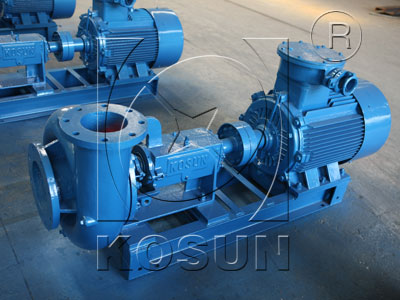What is the work principle centrifugal pump
2013-10-03
A centrifugal pump converts the input power to kinetic energy in the liquid by accelerating the liquid by a revolving device - an impeller. The most common type is the volute pump. Fluid enters the pump through the eye of the impeller which rotates at high speed. The fluid is accelerated radially outward from the pump chasing. A vacuum is created at the impellers eye that continuously draws more fluid into the pump.
If the discharge of a centrifugal pump is pointed straight up into the air the fluid will pumped to a certain height - or head - called the shut off head. This maximum head is mainly determined by the outside diameter of the pump's impeller and the speed of the rotating shaft. The head will change as the capacity of the pump is altered.

The kinetic energy of a liquid coming out of an impeller is obstructed by creating a resistance in the flow. The first resistance is created by the pump casing which catches the liquid and slows it down. When the liquid slows down the kinetic energy is converted to pressure energy.
It is the resistance to the pump's flow that is read on a pressure gauge attached to the discharge line. A decanter centrifuge pump does not create pressure, it only creates flow. The gauge pressure is a measurement of the resistance to flow.
The main reason for using head instead of pressure to measure a centrifugal pump's energy is that the pressure from a pump will change if the specific gravity (weight) of the liquid changes. The centrifugal pump's performance on any Newtonian fluid can always be described by using the term head.
News
- 07-11Technical features of using KOSUN drilling waste mud treatment system
- 07-07Main equipment of solids control system in drilling
- 06-26Geothermal well mud treatment system manufacturer—KOSUN solid control
- 06-26The key to achieving mud zero discharge is on-site processing after solid-liquid separation
- 05-10Application Scenarios of KOSUN Drilling Waste Treatment Equipment
- 05-10Environmental protection new regulations require to achieve zero discharge of drilling waste
- 05-09KOSUN Solid-liquid Separation Equipment is used in the construction industry
- 04-19What are the main functions of the Mud Agitator during use?
- 04-15The Advantages of KOSUN's trenchless horizontal directional crossing mud recovery system
- 03-15Vacuum degasser is mainly divided into centrifugal degasser and jet degasser




